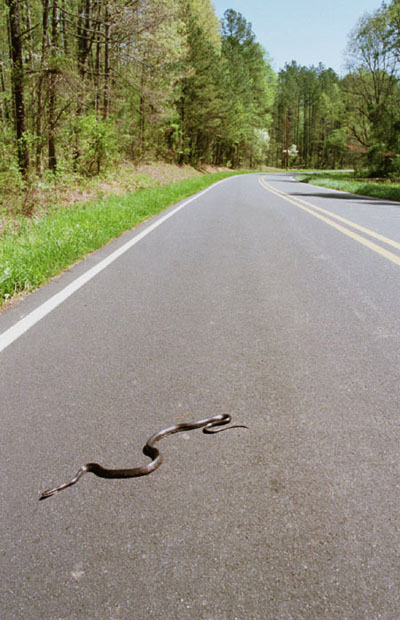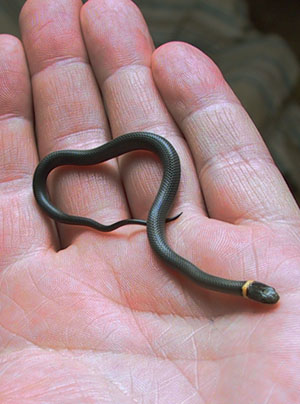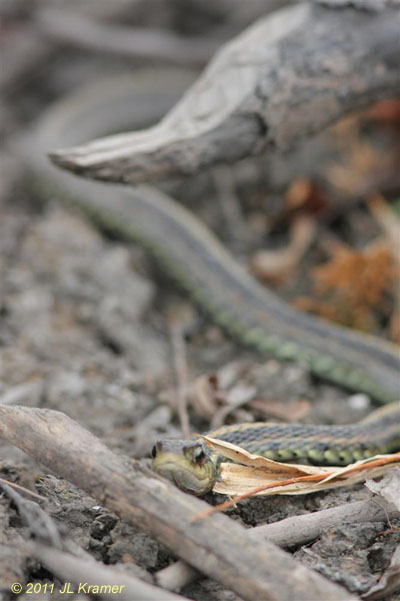I was skimming Why Evolution Is True on Thursday night just before midnight, when I discovered that July 16th (that very day, for ten more minutes,) was World Snake Day. Not a lot of point in trying to post something, even when I had a photo all lined up – not for World Snake Day, just because I’d shot it recently and was waiting for the opportunity to post it.
As luck would have it, though, today is Celebrate World Snake Day Three Days Late, which I am certainly on top of, and in checking out the blog folders, I find that I have more things to post than I initially believed. So let’s get partying!
 Our first comes from ’97, I think, when I was still shooting negative film, a black rat snake that I found sunning itself on a quiet country road. My guess would make this morning in the spring, when the nights were still cool and the snakes needed the warmth from the road for the energy to digest the night’s meal, and this seems to be born out by the presence of flowering trees in the distance. Asphalt is a great heat collector, as barefoot people in the summer know, but countless snakes get run over because of this, so in honor of the holiday, I remind everyone that, if they see something suspicious-looking in the road ahead, swerve around it. Or, as I did, get out, get your pics, then nudge it from the hazard zone.
Our first comes from ’97, I think, when I was still shooting negative film, a black rat snake that I found sunning itself on a quiet country road. My guess would make this morning in the spring, when the nights were still cool and the snakes needed the warmth from the road for the energy to digest the night’s meal, and this seems to be born out by the presence of flowering trees in the distance. Asphalt is a great heat collector, as barefoot people in the summer know, but countless snakes get run over because of this, so in honor of the holiday, I remind everyone that, if they see something suspicious-looking in the road ahead, swerve around it. Or, as I did, get out, get your pics, then nudge it from the hazard zone.
Hold on, I sit corrected; it is now an eastern rat snake (Pantherophis alleghaniensis,) because herpetologists have now distinguished this from a western variety, which got to keep the original name. You may hear about biologists naming new species in some creative way, after cartoonists or movie characters or some such, but let me tell you, those are the rare exceptions; if they can classify something as “eastern,” they’ll do it, because you can never have enough eastern somethings. Don’t believe me? Here’s a list of scientific names, just featured here in the blog, that demonstrate this:
common eastern bumblebee eastern bluebird eastern box turtle eastern boxelder bug eastern carpenter bee eastern cottontail rabbit eastern fence lizard eastern forktail eastern frustrated nature photographers eastern garter snake eastern grey squirrel eastern hognose snake eastern kingbird eastern kingsnake eastern leaf-footed bug eastern lubber grasshopper eastern narrowmouth toad eastern newt eastern pondhawk eastern rat snake eastern redbud eastern tiger swallowtail eastern towhee eastern yellowjacket southeastern five-lined skink
Okay, granted, one of those might not yet be recognized taxonomically, but give it time…
 While visiting New York many years ago – fourteen, to be precise – my brother and I happened across this charming little ring-necked snake (Diadophis punctatus,) so of course I had to do a scale photo in my brother’s palm. This is not a baby or juvenile, but their average size, small enough that The Girlfriend finds them cute (not so much with the larger species, let me assure you.) They are, of course, wickedly venomous, but their teeth are so small they are only a hazard to thin-skinned species like caterpillars and Republicans.
While visiting New York many years ago – fourteen, to be precise – my brother and I happened across this charming little ring-necked snake (Diadophis punctatus,) so of course I had to do a scale photo in my brother’s palm. This is not a baby or juvenile, but their average size, small enough that The Girlfriend finds them cute (not so much with the larger species, let me assure you.) They are, of course, wickedly venomous, but their teeth are so small they are only a hazard to thin-skinned species like caterpillars and Republicans.
No, that’s a lie, they’re not venomous at all, and not rare either, but they don’t come out into the open much so finding them usually requires poking around in dark spots, under leaves and among rocks. I think I’ve found them once around here.
For our next feature, we turn to someone else.
 Long, long ago, when mankind still had jutting brows and hairy palms (I mean, all of us, not just some,) there were going to be a few guest posts herein, and one contributor was Jim Kramer. Jim never finished the post to his liking and I sincerely doubt he’s going to tackle this one anytime soon, so I’m featuring it here since it’s been sitting in the blog folders all this time. This is an eastern garter snake (Thamnophis sirtalis sirtalis,) despite the fact that it was taken in Kansas; it was taken in eastern Kansas, so it appears we now know where the dividing line is. In all honesty, I looked up the range of the western species and it appears to stop just west of Kansas, so I think I’m both correct and safe on this one.
Long, long ago, when mankind still had jutting brows and hairy palms (I mean, all of us, not just some,) there were going to be a few guest posts herein, and one contributor was Jim Kramer. Jim never finished the post to his liking and I sincerely doubt he’s going to tackle this one anytime soon, so I’m featuring it here since it’s been sitting in the blog folders all this time. This is an eastern garter snake (Thamnophis sirtalis sirtalis,) despite the fact that it was taken in Kansas; it was taken in eastern Kansas, so it appears we now know where the dividing line is. In all honesty, I looked up the range of the western species and it appears to stop just west of Kansas, so I think I’m both correct and safe on this one.
The thing I like most about this image, aside from the fact that Jim also likes getting the lower portrait angles on his subjects when possible, is that the snake seems to form a dividing line between monochrome and color, much like Dorothy waking up in Oz. I’m wondering if Jim ever noticed this…
[The colors in this photo, I mean, not the bit about the Wizard of Oz – I imagine he caught that one.]
Jim went on to forward a lot of images to be featured here over the years, so he contributes, just not in writing form.

Did you see eastern worm snake in that list above? Well, this is one, the subspecies Carphophis amoenus amoenus, which I likely just identified as the parent species in earlier posts about them (because I know I’ve featured them at least a couple of times before.) At the same time that I was shooting the eentsy little frogs in this post, I was about to step across the drainage channel when I spotted this little guy in the grass, no mean feat because he was mostly obscured and about the diameter of a pencil. I’d sized the photo then but decided not to include it in that post, and it’s been sitting here waiting on the holiday ever since.
And finally, the most recent one, the one that I could have posted on World Snake Day had I been paying more attention (i.e., been reading blogs instead of doing other productive things that day.)

Okay, seriously. This is a member of the eastern racer species, sometimes known (especially here, because c’mon) as a black racer, but Coluber constrictor is the parent species. There are several subspecies, or which this is either the northern or more likely (from the range) the southern variant, which would make it Coluber constrictor priapus. The way to tell them apart – are you ready for this? – is by the penis, or to be more specific, the hemipenis, which is not a small organ possessed by Dodge owners, but snakes instead; on the southern variant, this organ has spines, because nature has a sick sense of humor. I have to admit that, amateur naturalist that I am, I did not determine this trait at the time, and for that I am ashamed/grateful. This one in particular was courting danger, in that it was perched in plain sight in late afternoon atop a mound of pine straw, against which it blended not at all, while I was out photographing the behavior of the Cooper’s hawks in the previous post; the spot on the ground where they’d been feeding was a handful of meters away. To its credit, it was holding perfectly still as I stood nearby, and I looked at the dark object on the pine straw for a few moments wondering if someone had discarded a length of hose before I discerned the raised head staring at me rudely. I had the 150-600mm attached for the hawks, so the apparent proximity of the snake really isn’t, and I could not have gotten such a tight closeup without it. Racers are aptly named, and can move quickly when threatened.
But it’s after noon now, a little later than I’d aimed, so I will post this and let others celebrate the holiday. There are still more photos in the folder, so just sit right there and keep refreshing the page so you see the new posts the second they appear.
[Don’t do that.]




















































